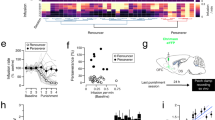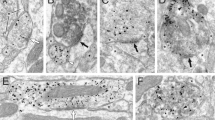Abstract
The manner in which drug-evoked synaptic plasticity affects reward circuits remains largely elusive. We found that cocaine reduced NMDA receptor excitatory postsynaptic currents and inserted GluA2–lacking AMPA receptors in dopamine neurons of mice. Consequently, a stimulation protocol pairing glutamate release with hyperpolarizing current injections further strengthened synapses after cocaine treatment. Our data suggest that early cocaine-evoked plasticity in the ventral tegmental area inverts the rules for activity-dependent plasticity, eventually leading to addictive behavior.
This is a preview of subscription content, access via your institution
Access options
Subscribe to this journal
Receive 12 print issues and online access
$209.00 per year
only $17.42 per issue
Buy this article
- Purchase on Springer Link
- Instant access to full article PDF
Prices may be subject to local taxes which are calculated during checkout


Similar content being viewed by others
References
Bowers, M.S., Chen, B.T. & Bonci, A. Neuron 67, 11–24 (2010).
Ungless, M.A., Whistler, J.L., Malenka, R.C. & Bonci, A. Nature 411, 583–587 (2001).
Bellone, C. & Lüuscher, C. Nat. Neurosci. 9, 636–641 (2006).
Good, C.H. & Lupica, C.R. J. Neurosci. 30, 7900–7909 (2010).
Mameli, M., Balland, B., Lujan, R. & Lüscher, C. Science 317, 530–533 (2007).
Luu, P. & Malenka, R.C. J. Neurophysiol. 100, 533–538 (2008).
Lamsa, K.P., Heeroma, J.H., Somogyi, P., Rusakov, D.A. & Kullmann, D.M. Science 315, 1262–1266 (2007).
Engblom, D. et al. Neuron 59, 497–508 (2008).
Kullmann, D.M., Min, M.Y., Asztely, F. & Rusakov, D.A. Phil. Trans. R. Soc. Lond. B 354, 395–402 (1999).
Wang, H.X. & Gao, W.J. J. Physiol. (Lond.) 588, 2823–2838 (2010).
Lane, D.A., Jaferi, A., Kreek, M.J. & Pickel, V.M. Neuroscience 169, 559–573 (2010).
Brown, M.T.C. et al. PLoS ONE 5, e15870 (2010).
Ungless, M.A. Trends Neurosci. 27, 702–706 (2004).
Conrad, K.L. et al. Nature 454, 118–121 (2008).
Mameli, M. et al. Nat. Neurosci. 12, 1036–1041 (2009).
Acknowledgements
We thank the members of the Lüscher laboratory as well as M. Frerking and A. Holtmaat for comments on the manuscript and B. Cerutti for help with the statistical analysis. This work is supported by the Swiss National Science Foundation (C.L.), the Systems X initiative of the Swiss Confederation (NeuroChoice, C.L.).
Author information
Authors and Affiliations
Contributions
M.M. carried out all experiments with two–photon laser glutamate uncaging. M.M., M.T.C.B. and C.B. contributed to the long-term plasticity experiments. C.L. designed the study together with M.T.C.B., C.B. and M.M. and wrote the manuscript with the help of all of the authors.
Corresponding author
Ethics declarations
Competing interests
The authors declare no competing financial interests.
Supplementary information
Supplementary Text and Figures
Supplementary Figures 1, 2 and Supplementary Methods (PDF 1342 kb)
Rights and permissions
About this article
Cite this article
Mameli, M., Bellone, C., Brown, M. et al. Cocaine inverts rules for synaptic plasticity of glutamate transmission in the ventral tegmental area. Nat Neurosci 14, 414–416 (2011). https://doi.org/10.1038/nn.2763
Received:
Accepted:
Published:
Issue Date:
DOI: https://doi.org/10.1038/nn.2763
This article is cited by
-
Sustained antidepressant effect of ketamine through NMDAR trapping in the LHb
Nature (2023)
-
Negative modulation of AMPA receptors bound to transmembrane AMPA receptor regulatory protein γ-8 blunts the positive reinforcing properties of alcohol and sucrose in a brain region-dependent manner in male mice
Psychopharmacology (2023)
-
Stress-driven potentiation of lateral hypothalamic synapses onto ventral tegmental area dopamine neurons causes increased consumption of palatable food
Nature Communications (2022)
-
Cocaine-induced projection-specific and cell type-specific adaptations in the nucleus accumbens
Molecular Psychiatry (2022)
-
Cocaine induces paradigm-specific changes to the transcriptome within the ventral tegmental area
Neuropsychopharmacology (2021)



